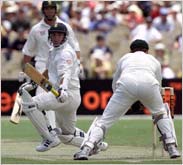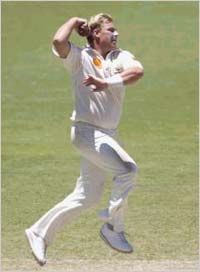South Africa short on star quality
Daniel Laidlaw
As contenders for the No. 1 title, South Africa began their series against
Australia with something to prove. Having failed to beat Australia in four
series since re-emergence, it was South Africa who were required to assert
their world No. 1 credentials. Despite a drawn series with New Zealand which
too many saw as the harbinger of an imminent downfall, Australia remained
the team to beat.
In the last two home-and-away series against the Australians, South Africa
were defeated by a side which not only performed the disciplined
fundamentals as professionally as they did, but had more initiative and
flair. Under new captain Shaun Pollock, it was thus up to this South African
team to show that they could outwit and outplay their Aussie rivals, rather
than wait for them to self-destruct in a gruelling battle which Australia,
with their superior quality and positive approach, would likely always win.
The first Test showed they still have a long way to go in this regard.
The first obstacle the South Africans had to contend with was the
Australians' love of playing against them. Far from being intimidated,
Australia actually seem to thrive on competing against another team which
overtly seeks to push them around. Whereas in touring the subcontinent there
is a certain fear factor over their own uncertainties against playing spin
bowling in conditions where they have been historically unsuccessful,
everything about South Africa’s brand of cricket is welcomed with relish
since it so closely resembles their own style of play.
With nothing separating them psychologically other than South Africa’s
history of coming second best, the difference is made on the field by the
ability and approach of the combatants. The third and fourth days in
Adelaide illustrated why Australia outplays South Africa in a contest
between two otherwise evenly-matched sides. The difference is star quality.
The main reason Australia is more often prepared to successfully take the
initiative is that they have more players with not only the confidence but
the calibre to do it. Entering day three, with South Africa 101/2, it was
clear that all wickets would be hard-earned. After the opportunistic run out
of nightwatchman Claude Henderson thanks to a reckless Gibbs call, Gibbs and
Kallis were united for a crucial fourth-wicket partnership, but McGrath and
Warne were equal to the occasion and dismissed both in consecutive overs
prior to lunch.
 Herschelle Gibbs, as an attacking and in-form player, is the most dangerous
of South Africa’s five specialist batsmen. He was also one of the few to use
his feet to Warne, but fell doing so when he was stumped down the leg side
for 78. In the following over, McGrath trapped the South African mainstay
Kallis lbw with an inswinging full toss for just 5, to make South Africa
178/5 in pursuit of Australia’s 439.
Herschelle Gibbs, as an attacking and in-form player, is the most dangerous
of South Africa’s five specialist batsmen. He was also one of the few to use
his feet to Warne, but fell doing so when he was stumped down the leg side
for 78. In the following over, McGrath trapped the South African mainstay
Kallis lbw with an inswinging full toss for just 5, to make South Africa
178/5 in pursuit of Australia’s 439.
They were pivotal, momentum-changing wickets, for although the increasingly
assured McKenzie and Boucher went on to add 141 for the seventh wicket, the
batsmen who might have dominated and set a platform for the rest to attack
had been removed. Without enough runs on the board to take liberties,
neither McKenzie nor Boucher could dictate to Warne bowling from around the
wicket, as Australia engaged South Africa on their own terms by grinding
them down and awaiting a mistake. With eight wickets between them in the
first innings, the quality of Warne and McGrath eventually won out.
It is difficult to see this changing dramatically, at least for the next two
Tests Down Under. Kirsten and Kallis are both experienced and high quality
batsmen but the less aggressive approach by them and others plays directly
into Australia’s hands, as it has done previously. Permitted to bowl how
they wish, the Australian attack will always emerge triumphant with a large
total behind them, and if the key trio are removed the rest add depth but
not firepower.
Like England in the Ashes, South Africa probably did not fully appreciate
how positively Australia now approach batting until actually bowling to
them. The ease with which Hayden and Mark Waugh piled on the runs on the
fourth day must have been especially concerning.
 McGrath and Warne are proven champions and in terms of wickets Australia’s
best bowling combination ever. By comparison South Africa, badly missing the
potential explosiveness of Allan Donald, boast only Shaun Pollock as a
bowler of world class, and he was below his best in the first Test. Also,
Lee and Gillespie are both better than South Africa’s next best, the fast
but so far inconsistent Nantie Hayward.
McGrath and Warne are proven champions and in terms of wickets Australia’s
best bowling combination ever. By comparison South Africa, badly missing the
potential explosiveness of Allan Donald, boast only Shaun Pollock as a
bowler of world class, and he was below his best in the first Test. Also,
Lee and Gillespie are both better than South Africa’s next best, the fast
but so far inconsistent Nantie Hayward.
Bowling for containment in the second innings once they could not capitalise
on Langer’s early wicket, South Africa were surprisingly powerless to
prevent the Australians from scoring at four per over and better than a run
a minute. Left-arm spinner Claude Henderson possibly found himself out of
his depth when Hayden and Mark Waugh were intent upon attacking him at every
opportunity and when Lance Klusener came on to bowl with a ring field,
Hayden was seeing the ball so well he was still able to blast him over the
on side.
Kallis and Ntini were the only bowlers Australia could not score freely
against, but they were never likely to stop the flow of runs with quick
strikes. Batting to set up a declaration, Hayden and Waugh put on a
dominating 181 in only 44 overs. Against South Africa on a fourth-day pitch,
it was not meant to be that easy.
As the first innings showed, though, it is never the same batsmen who are
relied upon. Langer and Hayden may be the lynchpins of the Australian
batting order at present, but before them it was the Waugh twins or somebody
else. Now, Gilchrist is always a threat and Martyn, with his third hundred,
is batting as well as anyone. The hallmark of Australia’s batting is that
someone always rises to the occasion when required, and the lower order can
usually be relied upon for valuable partnerships with a member of the top
seven.
South Africa typically have an even spread of contributors who importantly
are capable of batting a long time, but in contrast to Australia have
significantly less batsmen with the potential to dominate by scoring
quickly, especially without Gibbs or after a loss of wickets.
Adding to the difficulty of South Africa’s challenge is the additional
motivation the Australians took into this series against them. Now more so
than ever, competing against South Africa with their top dog reputation and
ranking at stake has brought out the best in an Australian team that had
appeared to be slightly lacking in enthusiasm against New Zealand. In
Adelaide, there was an increased intensity in the celebrations at the fall
of a wicket, as if enjoying the prospect of defeating the Proteas. The
first Test was Australia’s most complete performance of the season, though
the middle order still has room for improvement.
South Africa’s lack of match-winners is well compensated by outstanding
batting depth, well-drilled and disciplined bowling and committed fielding.
However, when both sides are playing at their peak, which South Africa were
beneath in all departments in Adelaide, the first Test still provided enough
proof that Australia’s star quality is likely to continue to give them the
edge.
More Columns
Mail Daniel Laidlaw